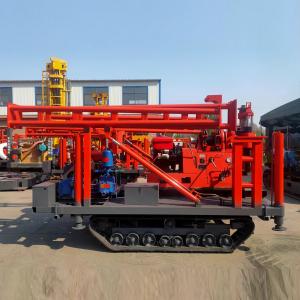
Add to Cart
GK 200 Borehole Crawler Mounted Geological Drilling Rig for Rock Drilling
Product Introduction
The drilling rig is applicable to the engineering geological survey of industrial and civil construction, railway, hydropower, transportation, bridge, dam foundation and other buildings; Geological core drilling and physical investigation; Drilling of small grouting holes, geothermal holes, blasting holes and various concrete detection holes; Small water well drilling and small foundation pile hole.
Product Tech Information
| Drilling depth | 200m | |
| Maximum open hole caliber | 300mm | |
| End hole caliber | 75mm | |
| Drill rod caliber | 60mm | |
| Drilling angle | 90°~75° | |
| Drill weight (No include power) | 975kg | |
| Unity machine dimensions | 1433×697×1273m | |
| Spindle | ||
| spindle speed | 64 128 287 557r/min | |
| Spindle stroke | 450mm | |
| Winch | ||
| Max.single line hoisting capacity | 2400kg | |
| Single line lifting speed | 0.41,0.82,1.64m/s | |
| steel wire rope caliber | 13m(35m) | |
| Mud pump | ||
| Type | Horizontal single urn twin-action | |
| Displacement | 170/150L/min(diesel or electromotor) | |
| Diesle engine | ZS1115 16.2kw 2200r/min | |
| Electric motor | Y160M—4 11kw 1440r/min | |
Product Features
1) It has a hydraulic feeding structure to improve the drilling efficiency and reduce the labor intensity of workers.
(2) The drilling rig is equipped with upper ball clamp clamping mechanism and hexagonal active drill pipe, which can reverse the rod without shutdown and is easy to operate.
(3) It is equipped with a hole bottom pressure gauge to indicate the pressure, which is convenient to master the situation in the hole.
(4) The handle is centralized and easy to operate.
(5) The base is equipped with an oil cylinder, which can move back and forth for easy lifting and lowering of drilling tools
(6) The drilling rig has the advantages of compact structure, small volume, light weight, strong decomposition and easy relocation. The loading form is trailer type, crawler type and disassembly. It is suitable for working in plain or mountainous areas.
Product Application
1.1 Engineering geological investigation of railways, hydropower, traffic, bridges, dam foundations and other buildings.
1.2 Geological core drilling, physical prospecting.
1.3 Small grout Confucius, drill hole drilling.
1.4 Small well drilling.
Soil Sampling Best Time and procedure
Soil samples can be taken any time throughout the year. It is important though to sample approximately the same time of the year. Late summer, or early fall, is a good time for most crops. This allows time for lime recommended to react and change the pH before the crop is planted
The specific steps of soil sampling method are as follows:
1. Distribution: samples shall be taken according to the soil type and the distribution of crop varieties, and according to the different soil fertility. The sampling points are distributed in zigzag or snake shape, which should be as uniform and random as possible.
2. Determine the sampling position and depth: the sampling position and depth shall be determined according to the thickness of the cultivated layer. Generally, the sampling depth is 0-20cm
Divide the field into different homogeneous units based on the visual observation and farmer’s experience.
Remove the surface litter at the sampling spot.
Drive the auger to a plough depth of 15 cm and draw the soil sample.
Collect at least 10 to 15 samples from each sampling unit and place in a bucket or tray.
If auger is not available, make a ‘V’ shaped cut to a depth of 15 cm in the sampling spot using spade.
Remove thick slices of soil from top to bottom of exposed face of the ‘V’ shaped cut and place in a clean container




